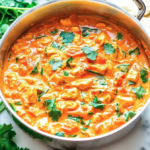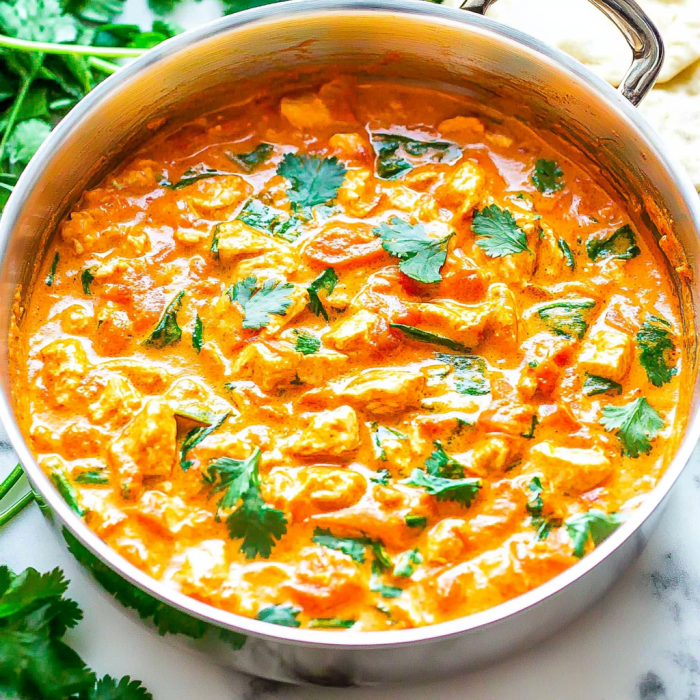If you’re craving a dish that brings the vibrant flavors of Thailand to your kitchen, look no further than Thai Chicken Coconut Curry. This aromatic and creamy curry combines tender chicken with a rich coconut milk sauce, infused with fragrant herbs and spices. Perfect for a weeknight dinner or a special occasion, this recipe is both simple and satisfying.
Ingredients:
- Chicken: 1 lb (450g) boneless, skinless chicken breasts or thighs, cut into bite-sized pieces
- Coconut Milk: 1 can (14 oz) full-fat coconut milk
- Curry Paste: 2-3 tablespoons Thai red or green curry paste (adjust to taste)
- Vegetables: 1 cup bell peppers, sliced; 1 cup baby corn; 1 cup snap peas
- Onion: 1 medium onion, finely chopped
- Garlic: 3 cloves garlic, minced
- Ginger: 1 tablespoon fresh ginger, grated
- Fish Sauce: 2 tablespoons (or soy sauce for a vegetarian option)
- Brown Sugar: 1 tablespoon
- Lime Juice: Juice of 1 lime
- Oil: 2 tablespoons vegetable or coconut oil
- Fresh Herbs: Fresh basil or cilantro for garnish
- Rice: Cooked jasmine rice, for serving
Instructions:
- Prepare the Ingredients: Start by slicing the chicken into bite-sized pieces and chopping the vegetables. Set them aside.
- Cook the Aromatics: Heat the oil in a large skillet or wok over medium heat. Add the chopped onion and cook until translucent, about 3-4 minutes. Add the minced garlic and grated ginger, and cook for another minute until fragrant.
- Add the Curry Paste: Stir in the curry paste and cook for 1-2 minutes, allowing the flavors to meld and the paste to slightly darken.
- Cook the Chicken: Add the chicken pieces to the skillet and cook until they are no longer pink, about 5-7 minutes.
- Add Coconut Milk: Pour in the coconut milk, stirring to combine. Bring the mixture to a simmer.
- Incorporate Vegetables: Add the bell peppers, baby corn, and snap peas. Simmer for another 5-10 minutes until the chicken is fully cooked and the vegetables are tender-crisp.
- Season the Curry: Stir in the fish sauce and brown sugar. Adjust the seasoning with more fish sauce or sugar if needed. Add the lime juice for a touch of brightness.
- Garnish and Serve: Serve the curry over cooked jasmine rice. Garnish with fresh basil or cilantro for added freshness and flavor.
Tips for the Perfect Thai Chicken Coconut Curry:
- Adjust the Spice Level: Thai curry paste varies in heat. Start with a smaller amount and add more if you prefer a spicier curry.
- Use Fresh Ingredients: Fresh ginger and garlic make a big difference in flavor compared to dried or powdered versions.
- Vegetable Variations: Feel free to add other vegetables like carrots, mushrooms, or zucchini based on your preference or what you have on hand.
- Leftovers: This curry keeps well in the fridge for up to 3 days and can be frozen for up to 3 months.
Why You’ll Love This Recipe
Thai Chicken Coconut Curry is not only delicious but also versatile. Its creamy, spicy, and slightly sweet flavors are sure to please your taste buds. Plus, it’s a one-pot dish, making cleanup a breeze. Whether you’re an experienced cook or a beginner, this recipe is straightforward and rewarding.
Serving and Storage Tips for Thai Chicken Coconut Curry
Serving Tips:
- Over Rice: Thai Chicken Coconut Curry pairs perfectly with jasmine rice. The fluffy, fragrant rice soaks up the creamy curry sauce, making each bite deliciously satisfying.
- Accompaniments: For added texture and flavor, consider serving the curry with a side of crispy fried wontons or spring rolls. A light cucumber salad with a tangy vinaigrette can also complement the richness of the curry.
- Garnishes: Enhance the dish with fresh garnishes such as chopped cilantro, basil, or mint. A squeeze of lime juice right before serving adds a burst of freshness and acidity that brightens up the curry.
- Adjust Spices: If you’re serving the curry to guests with varying spice tolerances, consider serving additional chili flakes or hot sauce on the side so everyone can adjust the heat to their liking.
- Make It a Meal: To make the meal more substantial, serve the curry with a side of steamed or sautéed greens, such as bok choy or spinach.
Storage Tips:
- Refrigeration: Store leftover Thai Chicken Coconut Curry in an airtight container in the refrigerator. It will keep for up to 3 days. Reheat thoroughly before serving.
- Freezing: This curry can be frozen for up to 3 months. To freeze, let it cool completely, then transfer it to a freezer-safe container or resealable bag. When ready to eat, thaw it in the refrigerator overnight and reheat on the stove over low heat, adding a little water or coconut milk if needed to reach the desired consistency.
- Reheating: When reheating, do so gently to avoid curdling the coconut milk. Heat over low to medium heat, stirring frequently. If the curry has thickened too much, add a splash of coconut milk or chicken broth to loosen it.
- Avoid Repeated Freezing: For best quality, avoid freezing and thawing multiple times, as this can affect the texture and flavor of the curry.
With these serving and storage tips, you can enjoy your Thai Chicken Coconut Curry at its best and ensure it remains a delicious and convenient meal option throughout the week!
1. Can I use a different type of curry paste?
Yes, you can use either red, green, or yellow Thai curry paste depending on your preference for spice and flavor. Red curry paste is typically spicier, while green curry paste has a fresh, herbaceous flavor, and yellow curry paste is milder and more aromatic. Adjust the amount based on how spicy you like your curry.
2. Can I make this curry vegetarian or vegan?
Absolutely! To make a vegetarian or vegan version, substitute the chicken with tofu or your favorite plant-based protein. Replace the fish sauce with soy sauce or tamari for a vegan option. Ensure the curry paste you use is vegan, as some may contain shrimp paste.
3. What can I use if I don’t have coconut milk?
If you don’t have coconut milk, you can substitute it with heavy cream or a mixture of regular milk and a bit of coconut extract for flavor. However, coconut milk provides a unique richness and flavor that’s integral to Thai curry, so it’s worth using if you can.
4. How can I adjust the curry’s thickness?
If the curry is too thick, add a bit of chicken broth or water to reach your desired consistency. If it’s too thin, let it simmer for a few more minutes to reduce and thicken. You can also stir in a slurry made from cornstarch and water if you need a quicker thickening option.
Print
Thai Chicken Coconut Curry
- Prep Time: 10 minutes
- Cook Time: 20 minutes
- Total Time: 30 minutes
- Yield: 4 servings
- Category: Main Course
- Method: Stovetop
- Cuisine: Thai
Description
This Thai Chicken Coconut Curry is creamy, spicy, and full of bold flavors. Tender chicken is simmered in a fragrant coconut milk curry sauce with veggies and Thai spices. Serve it over steamed jasmine rice for a comforting and satisfying meal that’s ready in about 30 minutes!
Ingredients
-
1 tbsp vegetable oil
-
1 lb boneless, skinless chicken breasts or thighs, cut into bite-sized pieces
-
1 small onion, sliced
-
2 cloves garlic, minced
-
1 tbsp fresh ginger, minced
-
1-2 tbsp red curry paste (to taste)
-
1 (13.5 oz) can coconut milk
-
1 tbsp fish sauce (or soy sauce for a milder option)
-
1 tbsp brown sugar
-
1 bell pepper, sliced
-
1 cup snow peas or green beans
-
Fresh basil or cilantro, for garnish
-
Lime wedges, for serving
-
Cooked jasmine rice, for serving
Instructions
-
Sauté the chicken:
Heat oil in a large skillet or wok over medium-high heat. Add chicken and cook until lightly browned, about 5–6 minutes. Remove and set aside. -
Build the flavor:
In the same pan, add onion, garlic, and ginger. Cook 2–3 minutes until softened and fragrant. Stir in red curry paste and cook for 1 minute. -
Add coconut milk & seasonings:
Pour in coconut milk, fish sauce, and brown sugar. Stir well to combine and bring to a simmer. -
Simmer with veggies:
Add bell pepper, snow peas, and cooked chicken back into the pan. Simmer for 8–10 minutes, or until chicken is cooked through and veggies are tender-crisp. -
Serve:
Spoon over rice and garnish with fresh herbs and lime wedges.
Notes
-
Adjust spice level by adding more or less curry paste.
-
Add other veggies like zucchini, carrots, or baby corn for variety.
-
Make it vegetarian by swapping chicken for tofu or chickpeas.

